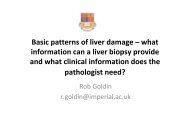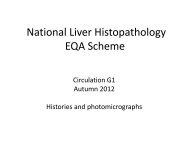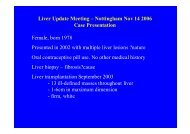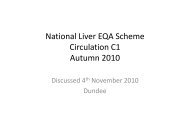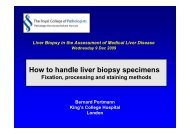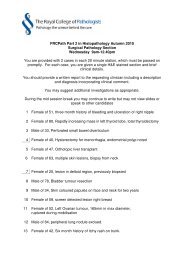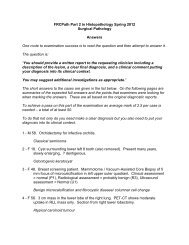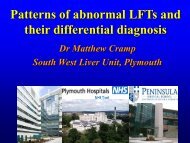with Judy Wyatt
Hepatitis C with Judy Wyatt - Virtual Pathology at the University of ...
Hepatitis C with Judy Wyatt - Virtual Pathology at the University of ...
Create successful ePaper yourself
Turn your PDF publications into a flip-book with our unique Google optimized e-Paper software.
Hepatitis C<br />
<strong>with</strong> <strong>Judy</strong> <strong>Wyatt</strong>
Hepatitis C and the histopathologist<br />
• Pre-2006 biopsy based treatment of<br />
moderate-severe chronic hepatitis<br />
• Now biopsy for:<br />
– Watchful waiting, to confirm mild disease<br />
– ? Cirrhosis – patient follow-up<br />
– Post transplant, protocol biopsies<br />
• Mainly want to know fibrosis stage
What do we mean by “liver fibrosis”?<br />
Differences between morphological appearance, description,<br />
stage scoring and liver fibrosis measurement<br />
Standish R et al. An appraisal of the histopathological assessment of liver fibrosis.<br />
Gut 55;569;2006
Biopsy based treatment<br />
Slide 08<br />
Moderate to severe<br />
hepatitis C<br />
defined as histological evidence of<br />
significant scarring (fibrosis)<br />
and/or<br />
significant necrotic inflammation.<br />
First NICE guidance October 2000<br />
Reviewed January 2004 – retain biopsy based treatment;<br />
may revise when results of mild hepatitis C studies are available<br />
August 2006 – treatment of mild chronic hepatitis C
Biopsy to determine severity of disease<br />
not an exact science<br />
What will the biopsy result depend on?<br />
• Time of biopsy – LFTs fluctuate<br />
• Biopsy site variation between biopsies<br />
• Biopsy length >25mm*<br />
• Biopsy width >1mm**<br />
Smaller biopsies underestimate severity<br />
Need >10 portal tracts**<br />
1998<br />
1.3mm<br />
wide<br />
2005<br />
0.56mm<br />
wide<br />
Which Pathologist? Inter-observer variation<br />
* Bedossa et al Hepatology 2003;38;1449-1457<br />
** Colloredo et al J Hepatol 2003;39;239-244
Effect of biopsy size on histological stage<br />
100%<br />
90%<br />
80%<br />
70%<br />
60%<br />
50%<br />
40%<br />
30%<br />
20%<br />
10%<br />
0%<br />
10x1.4 15x1.4<br />
15x1.0<br />
>30x1.4 >30x1.0<br />
biopsy size in mm<br />
Stage 1-2 stage 3-4 stage 5-6<br />
** Colloredo et al J Hepatol 2003;39;239-244
Histopathological features of<br />
chronic hepatitis C<br />
Non-specific – any chronic hepatitis<br />
– Inflammation – portal, interface, parenchymal<br />
– Fibrosis, architectural distortion<br />
Characteristic of hepatitis C<br />
– Steatosis<br />
– Portal lymphoid aggregates/follicles<br />
– Bile duct lesions<br />
– Fibrosis progression despite little inflammation<br />
And also<br />
different disease post transplant<br />
high frequency of HCC in cirrhosis – RNA virus
Hepatitis C characteristic histopathology
Introduction:<br />
x10 5
Hepatitis C:<br />
20 th anniversary of discovery<br />
The 1989 discovery of the hepatitis C virus by George Kuo, Qui-<br />
Lim Choo and Michael Houghton was a triumph of new techniques<br />
and good old human perseverance.
Who are you and where did you come from?<br />
• Hepacivirus, member of genus<br />
flavivirus, identified in 1989<br />
• can establish stable chronic<br />
infection in 80% people<br />
• Been around for centuries,<br />
but spreading in developed world due to travel and IVDU<br />
• RNA positive strand virus, error-prone replication,<br />
6 genotypes, many subtypes, and 1000’s of quasispecies<br />
• Very difficult to identify in cells and grow in culture
Tell me about you life<br />
• Outside – variable<br />
envelope protein and<br />
host lipoprotein<br />
• Inside – single strand<br />
RNA <strong>with</strong> ribosomal<br />
entry site, and core<br />
protein<br />
• Non-structural proteins<br />
for replication, and<br />
disturb host cell<br />
homeostasis
How do you get in?<br />
Four receptors on<br />
hepatocyte<br />
? Also other cell types,<br />
Dendritic cell –<br />
suppresses T cell<br />
responses<br />
Moradpour D, Penin F, Rice CM<br />
Nature Reviews Microbiology 5, 453–463
Chronic hepatitis C<br />
About 20% infections are cleared by<br />
host immune response – good array of<br />
strong T cell antigen responses<br />
Remaining 80% never cleared –<br />
more and more quasispecies evolve,<br />
escape immune response<br />
Other viruses – chronic in<br />
immuno-compromised host<br />
Hepatitis C – causes immune compromise<br />
specific for itself, reversible when virus is<br />
eradicated by antiviral treatment
Your host is not immunocompromised, how do<br />
you survive <strong>with</strong>out being eliminated?<br />
• In hepatocyte – virus reduces responsiveness to IFN<br />
• In Dendritic cell – inhibit helper T cell response<br />
PALT description
What about those bile duct lesions?<br />
• HCV +ve bile duct epithelium<br />
• HCV excreted in bile<br />
• HLA DR +ve bile ducts - ? Target for<br />
immune-mediated injury<br />
• Similarity <strong>with</strong> transplant rejection<br />
? Of any significance?<br />
No association <strong>with</strong> disease progression,<br />
and do not result in ductopaenia,<br />
Haruna et al.<br />
Hepatology 2001;33;977-980
Well let’s get to something that really is important<br />
– tell us about your relationship <strong>with</strong> fat...<br />
• Increases <strong>with</strong> stage of<br />
disease<br />
• Type 3 – effect of virus, other<br />
types synergy <strong>with</strong> risk factors<br />
for metabolic syndrome<br />
• Predicts progression<br />
• Associated <strong>with</strong> impaired<br />
response to treatment
Steatosis v stage of fibrosis in hepatitis C<br />
235 patients <strong>with</strong> liver biopsy and 65 transplanted for hepatitis C<br />
100%<br />
percentage of biopsies showing grade of steatosis<br />
90%<br />
80%<br />
70%<br />
60%<br />
50%<br />
40%<br />
30%<br />
20%<br />
10%<br />
0%<br />
no steatosis<br />
steatosis60% hepatocytes<br />
0 1 2 3,4,5 6 hepatectomy<br />
n=86 n=66 n=31 n=35 n=15 n=65<br />
No<br />
fibrosis<br />
Increasing fibrosis in liver<br />
Cirrhosis<br />
biopsy<br />
Transplant<br />
= end stage<br />
cirrhosis<br />
<strong>Wyatt</strong> J et al J Clin Pathol 2004
How do you do it?<br />
Two ways of causing steatosis:<br />
1. Viral steatosis, type 3a, direct cytopathic effect<br />
2. Metabolic steatosis, increases susceptibility to<br />
steatosis from metabolic causes<br />
? Also from alcohol<br />
Associated <strong>with</strong><br />
– increased fibrosis progression<br />
– lower response to treatment
What has steatosis got to do <strong>with</strong> fibrosis?<br />
Meta-analysis,<br />
3068 patients<br />
10 studies:<br />
Significant on<br />
Multivariate<br />
analysis<br />
Male<br />
Age<br />
Alcohol<br />
BMI<br />
DM<br />
Genotype 3<br />
Activity<br />
steatosis<br />
fibrosis<br />
Leandro et al. Gastroenterology 2006;130;1636-1642
Genotype 1 BMI 25<br />
Male<br />
Age<br />
Alcohol<br />
BMI<br />
DM<br />
Activity<br />
Male<br />
Age<br />
Alcohol<br />
BMI<br />
DM<br />
Genotype 3<br />
Activity<br />
steatosis<br />
fibrosis<br />
steatosis<br />
fibrosis
Metabolic steatosis:<br />
Hepatitis C and insulin resistance<br />
• HCV core protein associates<br />
<strong>with</strong> lipid droplet<br />
membrane and causes<br />
increased SOCS-3*<br />
% type II diabetes by age<br />
and HCV status<br />
• SOCS-3 does two things:<br />
– Promotes insulin resistance<br />
– Reduces response to IFN<br />
• Insulin is growth factor for<br />
fibroblasts, so more fibrosis<br />
* suppressor of cytokine signalling<br />
HCV –ve HCV +ve<br />
Mehta SH et al.<br />
Ann Intern Med 2000; 133:592–9.
Association between omental adipose tissue macrophages<br />
and liver histopathology in morbid obesity:<br />
The severity of fibro-inflammation in the liver is related to macrophage<br />
accumulation in the omental adipose tissue, independently of insulin resistance.<br />
Tordjman J et al. J Hepatol. 2009 Aug;51(2):354-62.
Why it’s bad to be overweight and have hepatitis C<br />
synergistic in liver disease:<br />
• Central obesity - NASH is the effect of adipocytokines from<br />
abdominal fat on steatotic hepatocytes<br />
• Hepatitis C sensitises liver to the effects of metabolic<br />
syndrome Greater insulin resistance relative to the<br />
degree of obesity
HCV and coronary artery disease<br />
82,000 HCV +ve<br />
89,500 HCV –ve<br />
HCV +ve were:<br />
Younger,<br />
Lower lipids<br />
Less hypertension<br />
But still they had 1.25<br />
relative risk of<br />
coronary artery<br />
disease after adjusting<br />
for other variables<br />
Butt et al. Clin Infect Dis 2009:49:225-232
Hepatitis C and HCC
RNA virus, so how can it cause cancer?<br />
Interferes <strong>with</strong> cell cycle:<br />
Cell cycle arrest – cells stuck in G1,<br />
Normal
What are your plans for the future?<br />
Estimated burden of end stage liver disease in HCV infected population,<br />
if patients are left undiagnosed and treated (England)<br />
3000<br />
2500<br />
2000<br />
1500<br />
1000<br />
predicted<br />
HES data<br />
500<br />
0<br />
1995 2000 2005 2010 2015<br />
Sweeting MJ et al. J Viral Hepatitis 2007;14;570-576
Summary – hepatitis C - virus of our time<br />
Hepatitis C has been infecting people since antiquity<br />
why is it suddenly so important?<br />
Couldn’t have known about it<br />
Not in developed countries<br />
Science:<br />
discovery,<br />
virology,<br />
pharmaceutical<br />
industry<br />
Transmission:<br />
worldwide travel,<br />
blood transfusion,<br />
IVDU<br />
Lifestyle<br />
age<br />
obesity<br />
alcohol<br />
viral co-infection<br />
Only clinically important late in stage disease



